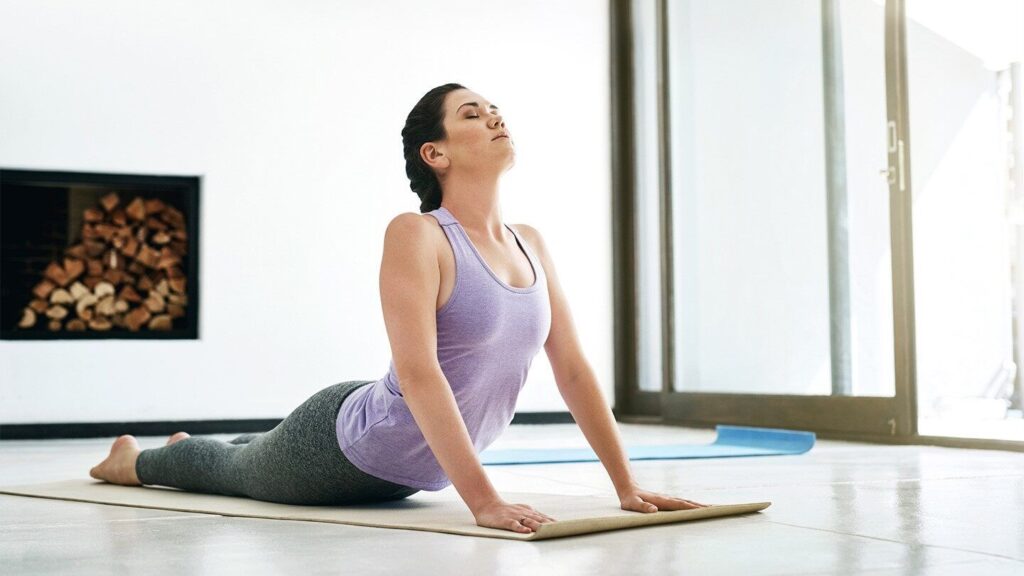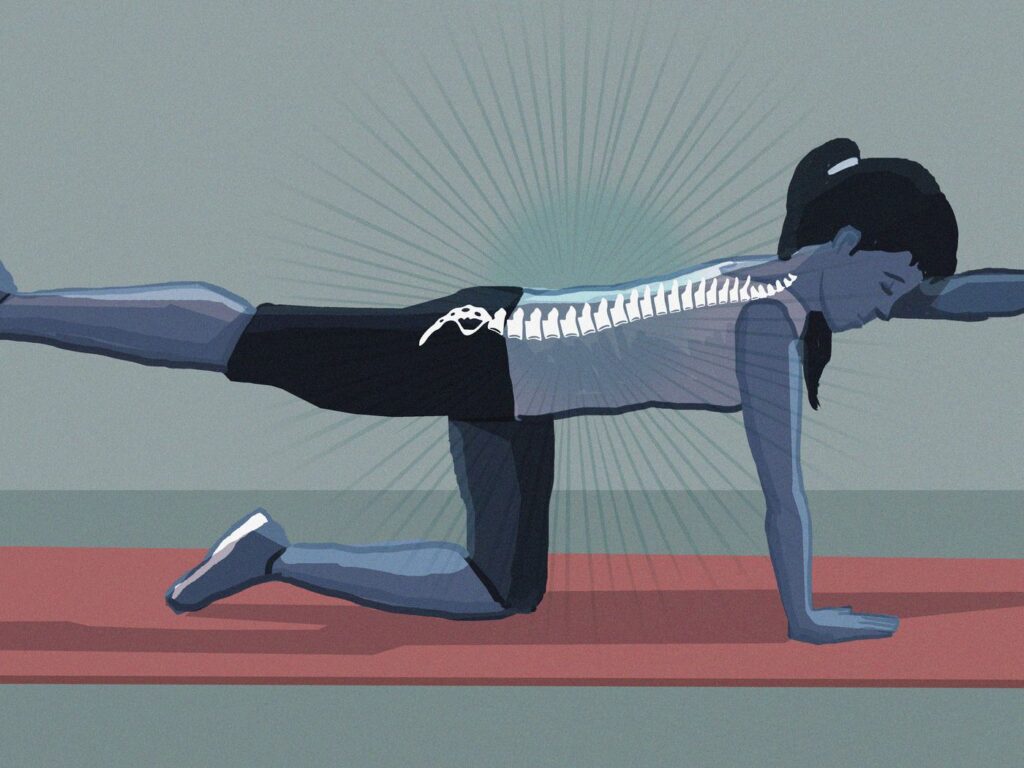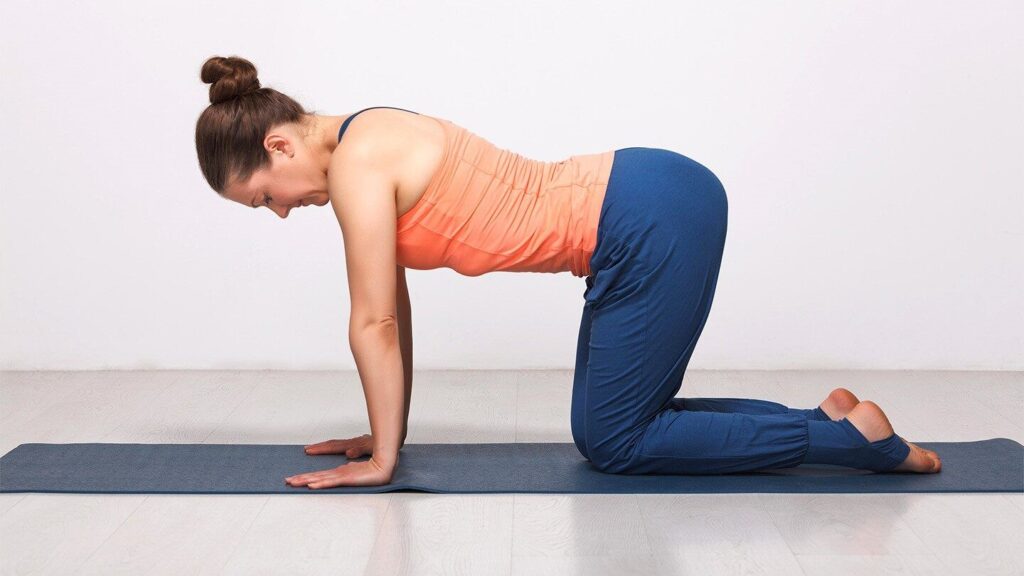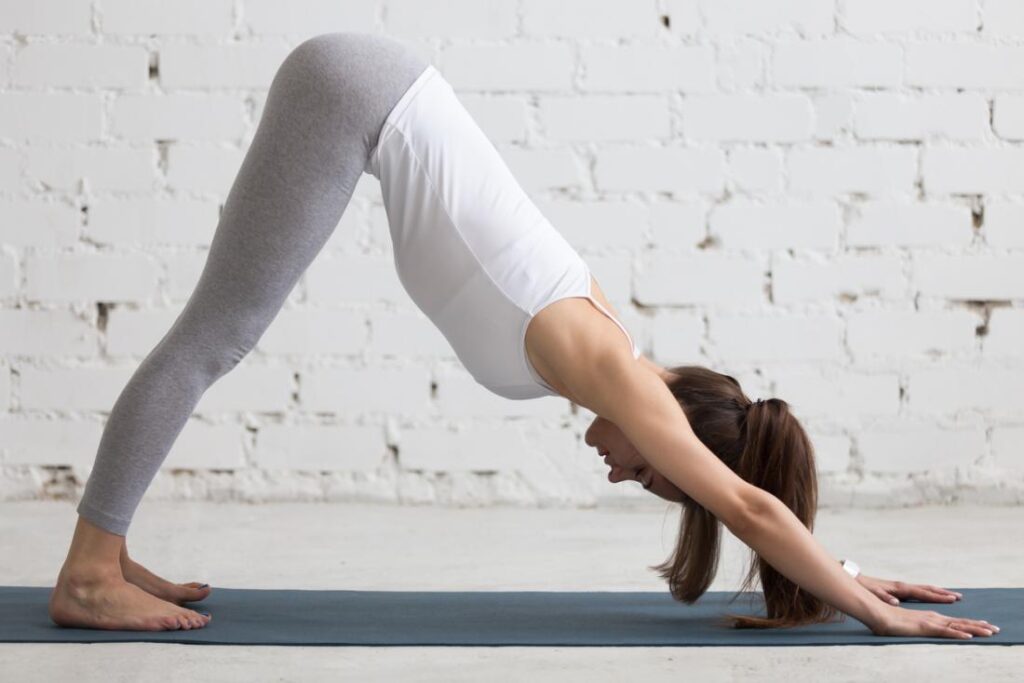
In the fast-paced life that characterizes much of the United States, low back pain has emerged as a common ailment afflicting many of us. With an ever-increasing number of individuals seeking alternatives to traditional medical interventions, the ancient practice of yoga offers a beacon of hope. We are drawn to investigate the reasons behind the effectiveness of this time-honored discipline in mitigating the discomfort associated with lower back issues. Our focus will shine a light on how the benefits of yoga for lower back pain are not only capable of providing relief but also of fostering resilience and spinal health.
Through our exploration, we aim to demystify the effectiveness of yoga in providing relief and enhancing the overall wellbeing of our spine. Join us as we delve into the transformative power of yoga for spinal health, examining why yoga helps reduce low back pain through its multifaceted approach to healing and maintenance of the body’s core structure.
Key Takeaways
- Understanding yoga’s holistic approach to alleviating low back pain.
- Exploring the tangible benefits of yoga for lower back pain sufferers.
- Examining the role of yoga in maintaining and improving spinal health.
- Discovering how specific poses and techniques target and reduce discomfort.
- Gaining insight into the preventive aspects of yoga against future lumbar issues.
Understanding Low Back Pain and Its Causes

The critical role yoga plays in managing low back pain is becoming increasingly clear as we delve into the causative factors contributing to this widespread issue. By examining the layers beneath the surface, we can see how yoga exercises for lumbar pain directly address the complexities involved.
Anatomy of the Lower Back
The lower back, or lumbar region, is an architectural marvel, comprising an interrelated network of muscles, vertebrae, and nerves. Each segment collaborates to support body weight and enable mobility. The spine’s alignment and muscular harmony are crucial in maintaining back health and preventing discomfort.
Common Triggers of Lumbar Discomfort
Low back pain can stem from various sources such as acute injury, poor posture, or even chronic conditions like arthritis. Yet, daily habits often silently set the stage for pain. Actions as mundane as improper lifting methods or prolonged sitting induce stress on lumbar structures, leading to pain and imbalance.
How Lifestyle Affects Spinal Health
Lifestyle factors wield a significant influence over spinal well-being. Repetitive behaviors, such as hunching over a desk or neglecting physical activity, culminate in weak back muscles and a spine ill-equipped to perform its duties. In contrast, integrating the importance of yoga for low back pain into our routines offers a potent remedy. Gentle stretches and strengthening exercises inherent to yoga not only soothe existing discomfort but also fortify against future episodes. Yoga’s core-strengthening and posture-aligning qualities directly counteract the effects of modern sedentary lifestyles and misaligned posture.
| Lifestyle Factor | Impact on Spinal Health | Yoga’s Therapeutic Role |
|---|---|---|
| Sedentary Behavior | Increased lumbar stress and muscle atrophy | Encourages movement and builds core stability |
| Poor Posture | Misalignment of spine and uneven muscle strain | Promotes alignment and corrects imbalances |
| Improper Lifting | Risk of acute lumbar injury | Strengthens lower back muscles and educates on body mechanics |
In our exploration, it becomes increasingly evident how yoga reduces back pain through a multifaceted approach. Yoga exercises for lumbar pain are not just remedial but also preventive, addressing the root causes of discomfort. It’s not just about temporary relief; it’s about creating a sustainable, pain-free foundation for a healthier back and lifestyle.
Why Yoga Helps Reduce Low Back Pain?

For a multitude of individuals seeking relief from lower back pain, the ancient practice of yoga provides not an esoteric escapade, but a tangible reprieve from chronic discomfort. As we delve into the benefits of yoga for lower back pain, it becomes evident that this mind-body discipline extends far beyond mere stretching—it’s a therapeutic conduit fostering spinal harmony and alleviating lumbar stress.
At the core of yoga’s effectiveness is its ability to strengthen the body while simultaneously increasing flexibility. This dual-action approach addresses the underlying contributors to back pain, which often include weak core muscles and a lack of spinal mobility. Through yoga therapy for chronic back pain, patients are discovering a path to not only mitigate their suffering but to also enact preventive measures against future discomfort.
- Gentle Movements: Gentle yoga postures encourage a slow and mindful exploration of one’s range of motion, facilitating a reduction in tension and an increase in spine flexibility.
- Strengthening the Core: A robust core is vital to spinal support; yoga poses designed to fortify the abdomen and lower back muscles contribute to a more resilient back.
- Posture Correction: By enhancing awareness of one’s body alignment, yoga aids in correcting postural imbalances that often lead to back pain.
- Increasing Mobility: Regular engagement in yoga increases the mobility of the spine, enabling the body to move more freely and with less pain.
| Aspect of Yoga | Benefits for Lower Back Pain |
|---|---|
| Mindful Breathing | Reduces stress and muscle tension, supporting the body’s natural healing process. |
| Flexibility Training | Enhances the range of motion in the hips and lower back, leading to diminished pain. |
| Strength Building | Develops the key muscle groups that stabilize the lower back, preventing further injury. |
We have observed, through consistent practice and patient testimonials, that yoga’s holistic approach offers a powerful remedy for those grappling with chronic pain. With each asana tailored to soothe and strengthen the lower back, a regular yoga regimen could very well be the cornerstone of an effective pain management strategy.
The Science Behind Yoga and Pain Relief

Our exploration into the scientific relationship between yoga and back pain relief reveals a fascinating intersection of biology and ancient practice. By delving into the mechanisms at work within our bodies during yoga, we can understand how yoga poses for back pain relief directly impact our physical wellbeing. Here, we’ll unpack the ways in which yoga fosters spinal health and how yoga reduces back pain through its effects on the nervous system and stress levels, as well as the role of endorphins.
Yoga and the Nervous System
Yoga’s ability to modulate the nervous system is central to its role in managing back pain. As we move through asanas specifically curated for spinal health, there is a notable decrease in the sympathetic nervous system’s activity—the system responsible for the ‘fight or flight’ response. This shift enables the parasympathetic nervous system to take the lead, promoting relaxation and healing. By activating this rest-and-digest mode, our bodies can better manage pain and initiate recovery.
Stress Relief and Its Effects on Pain
Stress exacerbates back pain by creating muscle tension and diminishing the body’s capacity to heal. Regular engagement in yoga for spinal health not only strengthens the back but also enhances stress resilience. By reducing the levels of stress hormones, such as cortisol, yoga practice allows us to break the cycle of stress and pain, providing a sanctuary of relief. Consequently, yoga acts as a therapeutic agent, addressing the psychological factors contributing to back pain.
The Role of Endorphins in Yoga
During yoga, our bodies release endorphins—natural painkillers that elevate mood and provide pain relief. This biochemical response is pivotal in how yoga reduces back pain. These ‘feel-good’ hormones are a key ingredient in the recipe of yoga’s healing effects, offering a holistic approach to managing chronic discomfort. Indulging in yoga poses for back pain relief stimulates the production of these endorphins, allowing practitioners to experience a substantial decrease in pain perception.
| Physical Impact | Psychological Benefit | Endorphin Response |
|---|---|---|
| Improves flexibility and strengthens back muscles | Reduces stress and anxiety levels | Increases endorphin production, which diminishes pain |
| Enhances body alignment and posture | Boosts mood and promotes relaxation | Contributes to a positive and uplifting sense of well-being |
| Encourages a balanced nervous system | Improves mental focus and concentration | Provides a natural and non-pharmacological pain management tool |
Key Benefits of Yoga for Lower Back Pain

As we delve into the many advantages of yoga for those with lower back issues, we uncover a series of transformative benefits. Yoga therapy for chronic back pain is not merely an alternative approach but a proven method to enhance physical and mental well-being. Those seeking the best yoga for lower back pain often find relief through targeted yoga exercises for lumbar pain, which offer a holistic healing experience.
- Improved Flexibility: Regular yoga practice gradually increases range of motion, helping to ease the stiffness that contributes to lower back pain.
- Stronger Muscles: Yoga strengthens the core, back, and abdominal muscles, providing better support for the spine.
- Better Posture: Heightened body awareness through yoga encourages proper alignment and posture, reducing strain on the back.
- Enhanced Mental Focus: The meditative components of yoga aid in stress reduction and focus, which are essential for managing chronic pain.
- Reduced Inflammation: The calming effect of yoga can diminish inflammation, which is often a contributor to back pain.
Incorporating yoga into our lives means addressing not just the symptoms of lower back pain, but working towards a root cause resolution. The movements and poses incorporated in yoga therapy are designed to stretch and strengthen the body, promote a healthier posture, and provide an overall sense of well-being. Thus, the practice of yoga embodies a comprehensive approach to managing chronic back conditions.Remember, consistency is key. To harness the full potential of yoga for alleviating lower back pain, make it a regular part of your wellness routine.
Exploring Yoga Therapy for Chronic Back Pain

The recognition of the importance of yoga for low back pain has grown considerably, positioning it as a valuable ally in the realm of chronic pain management. Investigating its role as a complementary treatment, we see yoga bridging the gap between modern healthcare practices and traditional wellness strategies. From enhancing flexibility to reducing stress, yoga’s multifaceted approach serves as a potent adjunct to conventional therapeutic measures. Let’s delve deeper into the ways that yoga therapy is changing the landscape for those enduring the persistent afflictions of back pain.
Yoga as a Complementary Treatment
Yoga’s compatibility with standard medical procedures speaks to its adaptability and the holistic benefits it brings to the table. Balancing the mind and body, yoga offers therapeutic exercises that gently engage and strengthen the back muscles, crucial for those suffering from chronic lumbar pain. The integration of yoga into a patient’s recovery regime can potentially accelerate the healing process while fostering a mindset conducive to pain management and overall well-being.
Case Studies: Yoga’s Impact on Chronic Pain
Substantial case studies pinpoint yoga therapy for chronic back pain as a transformative practice. Research participants have reported significant decreases in discomfort intensity and frequency, underscoring yoga’s efficacy. Anecdotal success stories are underpinned by clinical evidence, suggesting regular yoga sessions can not only assuage pain but also improve patients’ quality of life and functional capacity.
Integrating Yoga with Conventional Medicine
The symbiotic relationship between yoga and conventional medicine can yield enhanced outcomes for those contending with back pain. Yoga’s philosophy of establishing an equilibrium within the body complements medical treatments and may potentially reduce dependency on pharmacological interventions. Our analysis illuminates the opportunity to construct a comprehensive care plan that marries the restorative nature of yoga with the precision of medical science.
Yoga Poses for Back Pain Relief

Within the realm of holistic health, yoga poses for back pain relief stand out as an effective means to not only alleviate discomfort but also to help prevent future injuries. Our journey through the best yoga practices will introduce you to gentle asanas perfect for beginners, strengthening exercises for core stability, and restorative poses to nurture deep relaxation. Each category serves a unique purpose in fortifying the spine and mitigating lower back pain.
Gentle Asanas for Beginners
Beginners seeking relief from back pain can find solace in the gentle embrace of foundational yoga asanas. These poses are designed to ease the body into movement, stretch tight muscles, and promote alignment without overwhelming the practitioner. Early steps into yoga aim to offer reassurance and encouragement, ensuring that the benefits of yoga for lower back pain can be experienced by all.
Strengthening Poses for Core Support
Moving beyond the basics, one progresses into yoga’s strength-building arsenal. Core muscles are crucial in supporting the lower back; hence, we introduce poses that reinforce this muscular corset. Regular engagement of these strengthening poses helps develop a more resilient spine, equipped to handle the rigors of daily life and resist the strains that frequently lead to discomfort.
Restorative Yoga for Deep Relaxation
Lastly, the healing art of restorative yoga offers sanctuary to those with persistent back pain, providing poses that allow for deep relaxation. As the body settles into a state of repose, the nervous system is soothed, leading to a reduction in pain perception. This facet of yoga exemplifies the holistic approach taken towards health, considering the interconnectedness of body and mind in the pursuit of wellness.
| Yoga Pose | Category | Primary Benefit |
|---|---|---|
| Child’s Pose | Gentle Asana | Stretches lower back muscles |
| Pelvic Tilts | Strengthening Core | Improves lumbar stability |
| Corpse Pose | Restorative | Encourages full-body relaxation |
| Cat-Cow Stretch | Gentle Asana | Enhances spine flexibility |
| Bridge Pose | Strengthening Core | Fosters strong glutes and lower back |
| Legs-Up-The-Wall Pose | Restorative | Alleviates tension in hips and back |
Customizing Yoga Exercises for Lumbar Pain

At the core of our philosophy is the understanding that every individual experiences lumbar pain uniquely, which is why customizing yoga exercises for lumbar pain is essential. It’s not only about selecting the right poses but also about modifying them to suit your personal comfort and capability. Ensuring that yoga exercises are tailored to your needs can significantly enhance their effectiveness in addressing low back pain.
Adapting Poses for Individual Needs
To maximize the importance of yoga for low back pain, the adaptation of poses is crucial. For instance, a person with limited flexibility might use props like blocks or straps to maintain posture without straining the body. We encourage listening to your body and making adjustments that allow you to benefit from each pose fully.
The Importance of Proper Alignment
Understanding how yoga reduces back pain hinges on proper alignment. Misalignment can contribute to further discomfort or even injuries. That’s why we focus on alignment cues for each pose, ensuring that your body is positioned safely and effectively to foster healing and strength, not harm.
Creating a Personalized Yoga Routine
Developing a personalized yoga routine involves more than random selection of poses; it requires a strategic approach. We advocate a balance between poses that foster strength and those that promote flexibility, particularly targeting the muscles that support the lumbar region. Here’s a snapshot of how a personalized yoga routine might look:
| Yoga Exercise | Focus Area | Modification for Pain |
|---|---|---|
| Child’s Pose | Spinal Relaxation | Use a bolster under the torso for support |
| Pelvic Tilts | Core Stability | Perform lying down with knees bent if too challenging |
| Cobra Pose | Lower Back Strengthening | Keep elbows bent to reduce strain |
| Supine Spinal Twist | Mobility and Flexibility | Limit the range of twist and use a cushion between the knees |
By integrating these tailored yoga exercises for lumbar pain into your daily routine, you can take a proactive step towards managing and reducing your low back pain. Remember, a personalized approach can help you find relief, restore balance, and reclaim the joy of movement.
Encouraging a Journey Towards a Pain-Free Life
We have traversed the landscape of yoga as a substantial ally in the battle against lower back pain, underscoring the myriad of benefits it provides. Our journey uncovers the roots of why yoga helps reduce low back pain and reveals the potential it holds for improved spinal health. As we reach the culmination of this exploration, our focus now turns to integrating these insights into your life, crafting a path to resilience and comfort.
Summarizing the Healing Powers of Yoga
Throughout our discussions, the paramount benefits of yoga for lower back pain have emerged clearly: enhanced flexibility, a fortified core, and the serenity of mental focus. The best yoga practices for lower back pain are those that not only relieve discomfort but simultaneously promote a holistic sense of wellbeing, harmonizing body and mind. The potential for healing goes beyond temporary relief, hinting at a deeper, more sustainable form of recovery.
Finding the Right Yoga Path for Your Back Pain
In pursuit of a pain-free existence, it is vital to sift through the vast array of yoga styles and forms to uncover what resonates with your unique situation. Whether you’re a seasoned practitioner or a newcomer, yoga offers a spectrum of practices—from restorative poses to strength-building sequences—each capable of addressing specific aspects of your spinal health. We urge you to explore these with curiosity and openness, allowing your body’s inherent wisdom to guide you.
Seeking Professional Guidance
Embarking on this journey, particularly if you are contending with chronic pain, must be approached with care. Seeking professional guidance is a cornerstone of this process. A knowledgeable instructor can tailor asanas to align with your physical capabilities, ensuring that each movement contributes to your recovery. They provide insights that preempt the risk of further injury, allowing you to extract the optimum benefits yoga has to offer for your lower back pain.
FAQ
Why does yoga help reduce low back pain?
Yoga helps reduce low back pain by improving flexibility, strengthening the back muscles, enhancing alignment, and reducing stress, which can contribute to the tension and inflammation causing pain. It promotes a greater range of motion and corrects posture, leading to relief from lower back discomfort.
What are the benefits of yoga for lower back pain?
Benefits of yoga for lower back pain include increased back strength and flexibility, improved posture, reduced inflammation, enhanced mental focus, stress relief, and the stimulation of endorphin release, which can naturally ease pain. It also encourages the maintenance of a healthy spine.
Can yoga improve my spinal health?
Yes, yoga can significantly improve spinal health. Through specific poses that stretch and strengthen the spine, yoga promotes better alignment and supports the necessary muscle balance to protect the back. Additionally, it improves circulation and nutrient flow to the spinal tissues, aiding in recovery and maintenance.
What causes low back pain, and how can yoga help?
Low back pain can be caused by a variety of factors, including muscular imbalances, poor posture, sedentary lifestyle, or injury. Yoga helps by addressing these underlying issues through strengthening and stretching exercises, leading to improved muscle tone, balance, and posture which are essential for a pain-free lower back.
Does yoga serve as a therapy for chronic back pain?
Yoga can indeed serve as a therapeutic practice for chronic back pain. It offers a holistic approach to pain management that combines physical postures, breath control, and mindfulness to alleviate pain and improve quality of life. Many studies suggest yoga can significantly reduce chronic back pain and enhance functional ability.
What are the best yoga poses for back pain relief?
Some of the best yoga poses for back pain relief include Child’s Pose (Balasana), Cat-Cow Stretch (Marjaryasana-Bitilasana), Downward-Facing Dog (Adho Mukha Svanasana), Standing Forward Bend (Uttanasana), and Supine Spinal Twist (Supta Matsyendrasana). Each pose helps in different ways to stretch, strengthen, and release tension in the lower back.
How important is proper alignment in yoga for low back pain?
Proper alignment is crucial in yoga, especially for those with low back pain. It ensures that the spine is correctly supported and the surrounding muscles are engaged appropriately, preventing further injury and promoting healing. Understanding and maintaining proper alignment can maximize the therapeutic benefits of yoga.
Can yoga exercises be customized for my lumbar pain?
Absolutely, yoga exercises can and should be customized for individual lumbar pain concerns. By adapting poses and sequences to meet your body’s needs, you can gently work towards healing and strengthening your back. It’s advised to work with a yoga therapist or instructor trained in addressing back pain to create an effective and safe practice.
What should I consider when choosing yoga practices for my back pain?
When choosing yoga practices for back pain, consider factors like the severity of your pain, your overall physical condition, and any specific recommendations from healthcare providers. Start slowly with gentle poses, focus on alignment, and be consistent with your practice. Consulting with a yoga professional who understands spinal health can also provide valuable guidance.
Is professional guidance necessary for practicing yoga with back pain?
While not everyone may require professional guidance for practicing yoga, it’s highly recommended for those with back pain. A professional can help tailor a practice to accommodate your pain levels and physical limitations, offer modifications for poses, and ensure that you’re practicing safely to avoid exacerbating your pain.
